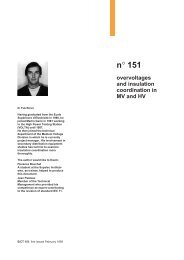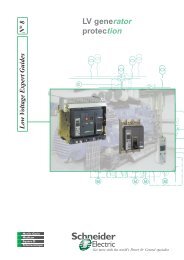Vigilohm System - engineering site - Schneider Electric
Vigilohm System - engineering site - Schneider Electric
Vigilohm System - engineering site - Schneider Electric
Create successful ePaper yourself
Turn your PDF publications into a flip-book with our unique Google optimized e-Paper software.
<strong>Vigilohm</strong>: functions and characteristics<br />
auxiliaries<br />
selection of auxiliaries<br />
A number of accessories are required for<br />
<strong>Vigilohm</strong> installations; other optional<br />
accessories can be provided:<br />
c essential auxiliary;<br />
v optional auxiliary.<br />
<strong>Vigilohm</strong> XM200 XGR TR22A TR22AH EM9 cat. No<br />
XM300C<br />
EM9B<br />
XML308<br />
EM9T<br />
XML316<br />
U < 760 VAC (4) 760 à 1700 VAC (4)<br />
U < 440 VAC (5) 440 à 1000 VAC (5)<br />
U < 500 VDC (6) 500 à 1200 VDC (6)<br />
"250 V " Cardew C (1) or c c c c (2) 50170<br />
"440 V" Cardew C (1) or c c c c (2) 50171<br />
"660 V" Cardew C (1) or c c c c (2) 50172<br />
"1000 V" Cardew C (1) or c c c c (2) 50183<br />
Cardew C base v v v v v 50169<br />
P1 subassembly c (3) 50211<br />
ZX limiting impedance v v v v v 50159<br />
S3 inductive neutral point i 380V v v v 50113<br />
PHT 1000 additional subassembly c except XM200 50248<br />
(1) See choice of the type of Cardew C (250, 440, 600 or 1000 V) below.<br />
(2) The use of a Cardew C is unnecessary with the EM9T.<br />
(3) Necessary for TR22A used on installations with U > 440 V.<br />
(4) Neutral distributed.<br />
(5) Neutral not distributed.<br />
(6) DC installation.<br />
041857<br />
auxiliary<br />
characteristics<br />
Cardew C surge limiter<br />
c on LV network with isolated or impedanceearthed<br />
neutral;<br />
c connected to the secondary of the MV/<br />
LV transformer to discharge overvoltages to<br />
earth;<br />
c capable of withstanding the short-circuit<br />
current of the transformer;<br />
c its operation causes continuous indication<br />
on the insulation monitor.<br />
E12128<br />
MV/LV<br />
cardew C<br />
L3<br />
L2<br />
L1<br />
N<br />
connection<br />
Characteristics<br />
c non-arcing voltage at 50 Hz<br />
160<br />
130<br />
50<br />
i 1.6 x nominal U;<br />
c certain arcing voltage at 50 Hz<br />
u 2.5 x nominal U (3 x nominal U for 220 V);<br />
c maximum current after arcing:<br />
2 Ø13<br />
40 kA/0.2 sec;<br />
Ø70<br />
2 Ø7<br />
c insulation resistance > 10 10 ohms;<br />
M12<br />
100<br />
c cartridge not reusable;<br />
c temperature range:<br />
v operating: - 5 °C to + 40 °C,<br />
v storage: - 25 °C to + 70 °C.<br />
Standards<br />
NF C 63-150, NF C 15-100.<br />
Weight: 1 kg.<br />
Cardew selection table<br />
The selection depends on:<br />
c the operating voltage Un of the installation;<br />
c the installation insulation level;<br />
c the connection point (neutral-earth or<br />
phase-earth).<br />
Un: ph.-ph. operat. voltage of the AC instal. Ui arcing voltage Cardew C<br />
neutral distributed neutral not distributed "type"<br />
U i 380 V U i 220 V 400 V < Ui i 750 V "250 V"<br />
380 V < U i 660 V 220 V < U i 380 V 700 V < Ui i 1100 V "440 V"<br />
660 V < U i 1000 V 380 V < U i 660 V 1100 V < Ui i 1600 V "660 V"<br />
1000 V < U i 1560 V 660 V < U i 1000 V 1600 V < Ui i 2400 V "1000 V"<br />
Connecting conductor size<br />
c cable or bar with a size adapted to the<br />
transformer rating<br />
c the connecting conductor should be<br />
considered to be a protective conductor<br />
(PE) and the calculation of its crosssectional<br />
area must satisfy applicable<br />
installation standards, considering that this<br />
part of the installation is protected by<br />
protective devices located upstream of the<br />
MV/LV transformer;<br />
c according to standard IEC 364, the<br />
formula for the calculation of the of the size<br />
of the PE conductor is: S = √I 2 t/k<br />
where S is the cross-sectional area of the<br />
E12043<br />
PE conductor in mm 2 ,<br />
I is the fault current, t is the operating time of<br />
the protective device and k is a coefficient<br />
that depends on the metal and insulation<br />
material used for the conductor.<br />
c recommendation: if insulation monitoring is<br />
provided using the <strong>Vigilohm</strong> <strong>System</strong>, install a<br />
type A toroid on the Cardew earthing circuit<br />
in order to monitor operation of the Cardew.<br />
The toroid can be connected to an XD301/<br />
312 detector or an XL308/316 or XML308/<br />
316 locating device.<br />
43

















